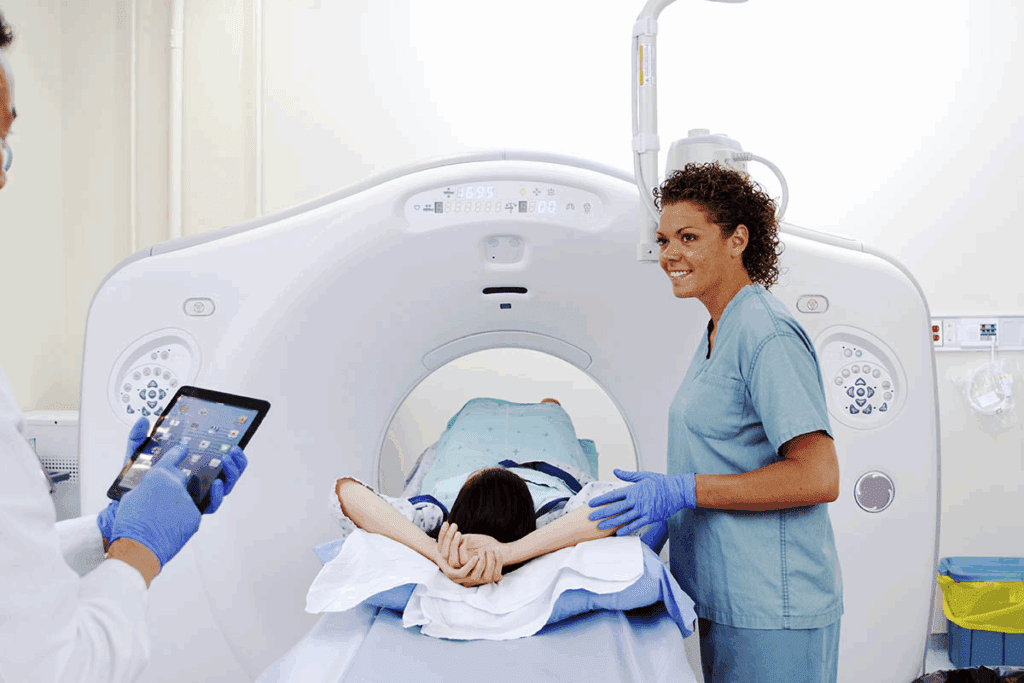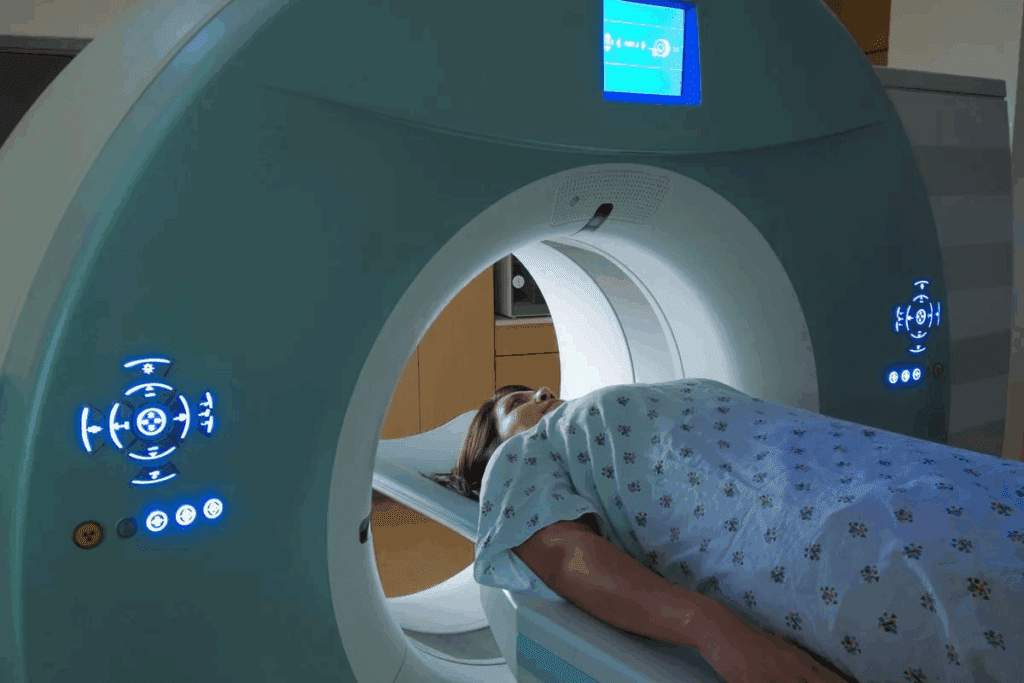Last Updated on November 27, 2025 by Bilal Hasdemir

Cancer diagnosis has become more precise with advancements in medical imaging, like Positron Emission Tomography (PET). The Standardized Uptake Value (SUV) is a key part of PET scans. It helps assess how severe cancer is.
A high SUV in cancer often means the tumor is very active. This suggests the cancer is aggressive. Knowing about SUV is key to diagnosing and staging cancer. It also helps track how well treatments are working.
The importance of SUV in cancer imaging is huge. It gives us numbers to understand how active a tumor is. This article will explore SUV, how it’s measured, and why it’s so important in fighting cancer.
Key Takeaways
- SUV is a critical metric in PET scans for assessing cancer severity.
- A high SUV often indicates aggressive cancer due to increased metabolic activity.
- Understanding SUV is vital for cancer diagnosis, staging, and monitoring treatment response.
- SUV provides quantitative information about tumor activity.
- Accurate interpretation of SUV is essential for effective cancer management.
Understanding SUV in PET Scan Imaging

Getting a cancer diagnosis right depends a lot on SUV values from PET scans. SUV, or Standardized Uptake Value, is key in nuclear medicine. It shows how severe and widespread cancer is.
Definition of Standardized Uptake Value (SUV)
The Standardized Uptake Value (SUV) is a way to measure how much a radioactive tracer, like FDG (Fluorodeoxyglucose), is taken up in a certain area. It’s found by looking at the activity in a tumor and comparing it to the dose given and the patient’s weight.
This SUV calculation is important. It helps doctors tell if a tissue is normal or cancerous. A high SUV usually means the tissue is very active, which is common in cancer.
How SUV is Measured and Calculated
A few steps are taken to find the SUV. First, the patient gets a radioactive tracer, like FDG. This tracer goes to very active areas. Then, a PET scanner picks up the radiation, making images that show where the tracer is most active.
The SUV is calculated using a formula: SUV = (tissue activity / injected dose) / body weight. This formula makes it possible to compare SUVs from different scans and patients.ignificance in Cancer Diagnosis
The SUV value is crucial for diagnosing, staging, and checking how well treatments work. A high SUV can mean the tumor is growing fast. This helps doctors decide the best treatment.
Also, SUV values help see if treatments are working. If the SUV goes down, it means the treatment is helping. But if it stays the same or goes up, the treatment might be ineffective.
So, Understanding SUV in PET scans is essential for doctors to provide accurate diagnoses and effective treatment plans.
The Fundamentals of PET Scan Technology

Positron Emission Tomography (PET) is key in molecular imaging. It’s used a lot in cancer diagnosis and management. PET scans use small amounts of radioactive tracers to see how the body’s cells work.
How PET Scans Work
PET scans detect gamma rays from a radioactive tracer, like Fluorodeoxyglucose (FDG). This tracer goes to areas with lots of activity, like cancer cells. The scanner then makes detailed images of the body’s inside.
Role of FDG in Cancer Detection
FDG is like glucose that cells use. Cancer cells use more of it because they grow fast. This makes FDG great for finding and checking cancer. The Standardized Uptake Value (SUV) shows how much FDG is used, helping to see how serious the cancer is.
Integration with CT and MRI
PET scans are often used with Computed Tomography (CT) or Magnetic Resonance Imaging (MRI). This mix gives both how the body works and its structure. It makes cancer diagnosis and planning more accurate. PET/CT scans are very useful because they show the body’s function and shape.
The SUV PET Scan Procedure Explained
Knowing how an SUV PET scan works is key for those getting tested for cancer. It covers steps from getting ready to the scan and what happens afterward.
Patient Preparation Requirements
Before an SUV PET scan, patients need to get ready properly. This includes:
- Fasting for 4-6 hours to avoid sugar effects
- Not doing hard exercise before the scan
- Telling the doctor about any meds, allergies, or health issues
- Getting there early to fill out forms and get ready
Wearing comfy clothes and no metal jewelry is also a good idea. It helps avoid scan problems.
What to Expect During the Scan
During the SUV PET scan, you’ll lie on a table that moves into a big scanner. It’s usually not painful, but you might feel a bit uncomfortable because you have to stay very quiet and calm for a while.
The scan uses a special dye that goes into cancer cells. This dye is picked up by the scanner, showing detailed pictures of your body’s inside parts.
Post-Scan Protocols
After the PET scan SUV, you can usually go back to your normal day unless your doctor says not to. Drinking lots of water helps get rid of the dye.
Also, know about what happens next. This includes when you’ll get your scan results and if you need more tests or visits.
Understanding the SUV PET scan helps patients get ready better. This makes the whole process smoother and more accurate.
Normal vs. Abnormal SUV Ranges
Understanding SUV values is key to spotting and treating cancer. The Standardized Uptake Value (SUV) is a key tool in PET scans. It helps doctors tell normal from abnormal cell activity.
Baseline SUV in Healthy Tissues
In healthy tissues, SUV values are usually low. This is because these tissues don’t have the high metabolic rates seen in cancer. For example, the liver, brain, and muscles have their own baseline SUV values. These values help doctors spot abnormal uptake.
What Constitutes an Elevated SUV
An elevated SUV means cells are using more glucose, often a sign of cancer. But, it’s important to remember that inflammation, infection, and some benign conditions can also raise SUV values. So, understanding the patient’s situation is key to interpreting SUV values.
Factors Affecting SUV Measurements
Many things can change SUV measurements. These include how the patient is prepared, the scanner’s setup, and the PET scan type. Blood sugar levels, body weight, and the time between tracer injection and scan also play a role. Knowing these factors is essential for correct SUV PET scan results interpretation.
Getting SUV values right is critical for managing cancer well. By knowing the normal and abnormal SUV ranges, doctors can make better decisions. This includes diagnosing, planning treatments, and checking on patients later.
What is Considered a High SUV in Different Cancer Types
Different cancers show unique SUV patterns. This means we need to understand these values well for accurate diagnosis. The right SUV value is key in cancer imaging. It affects treatment choices and patient results.
Lung Cancer SUV Thresholds
In lung cancer, SUV values show how active tumors are. A high SUV value often means the disease is more aggressive. Research shows an SUV over 10-15 might mean cancer is more likely.
A study in the Journal of Nuclear Medicine found a high risk of cancer in lung nodules with an SUV over 12.
Breast Cancer SUV Interpretation
Interpreting SUV values in breast cancer is complex. It depends on the type of breast cancer. Generally, an SUV over 5-7 is high, but it can change based on the cancer type.
- ER-positive tumors may have lower SUV values.
- HER2-positive tumors often exhibit higher SUV values.
- Triple-negative breast cancers typically show higher metabolic activity.
Lymphoma and SUV Values
Lymphoma SUV values are key for checking disease activity and treatment response. An SUV over 10 usually means the disease is active.
Colorectal Cancer SUV Patterns
In colorectal cancer, SUV values help spot disease that has come back or spread. An SUV over 5 is usually seen as significant.
A study in the Journal of Clinical Oncology showed SUV values are key in finding colorectal cancer that has come back. Early detection leads to better outcomes.
Knowing the right SUV values for each cancer type is vital for accurate diagnosis and treatment planning. As cancer imaging gets better, SUV PET scans will keep playing a big role in oncology.
SUV Values Across Different Cancer Stages
It’s important to know how SUV values change with cancer stages. SUV values show how active tumors are, which changes as cancer grows.
Early-Stage Cancer SUV Patterns
In early cancer, SUV values are usually lower. This is because the tumor is small and not very active. But, some early cancers can have high SUV values, showing they might grow fast.
- Low SUV values: Often seen in slow-growing tumors.
- High SUV values: May indicate a more aggressive cancer subtype.
Advanced Cancer SUV Characteristics
As cancer gets worse, SUV values go up. This shows the tumor is more active and aggressive. Advanced cancers take up more glucose, leading to higher SUV values.
The signs of advanced cancer SUV values are:
- Increased SUVmax values.
- Higher metabolic tumor volume.
- More varied SUV distribution in the tumor.
Metastatic Disease SUV Presentation
In metastatic disease, SUV values can differ in each metastasis. Some metastases might have higher SUV values than others, based on their location and biology.
Important points about metastatic disease SUV presentation are:
- Variability in SUV values: Across different metastatic lesions.
- Highest SUV values: Often found in lymph node or visceral metastases.
Knowing SUV values at different cancer stages is key for nuclear medicine and diagnostic radiology experts. It helps them make accurate diagnoses and plan treatments. When comparing suv pet scan vs other scans, SUV values give special insights into tumor metabolism. They help other imaging methods in cancer diagnosis.
Interpreting SUV PET Scan Results
Understanding SUV PET scan results is a detailed task. It combines two main steps: measuring and looking at the images. This way, doctors can spot and track cancer accurately.
Quantitative vs. Qualitative Assessment
Measuring SUV values shows how active tumors are. This helps doctors know if a tumor is aggressive. Looking at the images helps doctors see where and how active the tumor is.
Together, these steps give a full picture of the disease. For example, a high SUV value means a tumor is very active. The images show where it is and how it might affect nearby tissues.
The Role of Maximum SUV (SUVmax)
SUVmax is key in reading PET scans. It shows the highest activity in a tumor. This helps doctors understand how aggressive the tumor is and if it’s changing.
The SUVmax value helps decide on treatments. A drop in SUVmax after treatment is good. But an increase means the disease might be getting worse.
Understanding SUV Reports
SUV reports detail what a PET scan finds. They include SUV values, where tumors are, and more. Doctors need to study these reports to plan the best treatment.
Important parts of an SUV report are the SUVmax value, tumor size and location, and how the tracer is taken up. By looking at these, doctors can make better decisions for their patients.
Clinical Decision-Making Based on SUV
The SUV value is very important in making treatment plans. A high SUV value might mean more aggressive treatment. A low value might mean a gentler approach.
Also, SUV values help track how well treatment is working. This lets doctors adjust the treatment plan to fit each patient’s needs. SUV PET scans help make cancer care more personal.
Clinical Significance of High SUV Values
High SUV values in PET scans are key for cancer treatment success. They often point to aggressive tumors. This info helps doctors decide on the best treatment.
Correlation with Cancer Aggressiveness
High SUV values link to aggressive cancer types. Research shows these tumors grow fast and are likely to be cancerous. This is important in oncology imaging for spotting patients needing stronger treatments.
Prognostic Implications
High SUV values mean a tougher fight for patients. Those with high values might face a worse outcome than those with low values. This is key for doctors when talking about treatment and what to expect.
A lung cancer study showed high SUV values linked to shorter survival times.
Treatment Planning Based on SUV
Treatment plans change with SUV values. High values might mean more intense treatments like chemo or radiation. Low values could mean a gentler approach. The suv pet scan helps in finding tumors and staging them accurately.
Here are key points for treatment planning based on SUV values:
- High SUV values may need more aggressive treatment.
- Lower SUV values might suggest a gentler treatment plan.
- SUV values help check if treatment is working.
Understanding SUV values helps doctors make better cancer treatment choices. This leads to better patient results and more precise oncology imaging.
SUV PET Scan vs. Other Imaging Modalities
The SUV PET scan has changed how we diagnose cancer. It gives us a detailed look at how tumors work. This is key in molecular imaging. It’s important to see how SUV PET scans compare to other imaging methods.
Comparison with Conventional CT
CT scans show us the body’s structure well. But they don’t tell us about the body’s functions like SUV PET scans do. PET CT scans mix PET’s metabolic info with CT’s body details. This makes them great for cancer diagnosis.
Unlike CT scans, SUV PET scans spot cancer by its activity. This is super helpful for finding cancer early or spotting it again.
Advantages Over MRI in Certain Cancers
MRI is known for its clear images of soft tissues. It’s often paired with SUV PET scans. But SUV PET scans have special benefits for some cancers, like lymphomas. They show how active the tumor is, which MRI might miss.
- SUV PET scans add metabolic info to MRI’s body details.
- In some cancers, SUV PET scans are better at showing how far the disease has spread or if it’s coming back.
Integration with Other Diagnostic Methods
Using SUV PET scans with CT and MRI makes diagnosis better. Molecular imaging like SUV PET scans is part of a bigger diagnostic plan. This way, doctors get a full view of the disease. It helps them make better treatment choices.
By mixing SUV PET scans with other imaging, doctors can make treatments more precise. This leads to better care for patients.
Benefits and Limitations of SUV PET Scan
PET scans using SUV measurements are key in fighting cancer. They are a vital tool in nuclear medicine. They help see how tumors work and spread.
Key Advantages in Cancer Management
The SUV PET scan has many benefits in cancer care. It helps find cancer early and know how far it has spread. This lets doctors act fast.
It also checks how well treatments are working. This helps doctors change plans if needed.
Another big plus is spotting changes in tumors. This shows if treatments are working or not. Knowing this helps doctors make better choices.
Technical and Interpretive Limitations
But, SUV PET scans have some downsides. Things like how the scanner is set up and how images are made can change results. Also, things like blood sugar and body weight can affect readings.
There are also challenges in understanding the scans. Sometimes, scans can show false positives or negatives. This can happen if there’s inflammation or if tumors don’t show up well.
Standardization Challenges
It’s hard to make SUV PET scans the same everywhere. Different scanners and software make it tough. This makes it hard to compare results.
To fix this, guidelines for scans and analysis are being made. Using phantom studies helps make sure scanners are right. This makes SUV measurements more reliable.
SUV PET Scan Accuracy in Cancer Diagnosis
In cancer diagnosis, SUV PET scans are key. They help doctors understand the disease, plan treatments, and check how well treatments work.
Sensitivity and Specificity Rates
The quality of SUV PET scans is measured by their sensitivity and specificity. Sensitivity is how well the test finds people with the disease. Specificity is how well it finds people without the disease. SUV PET scans are very good at both for many cancers.
- Sensitivity rates help find cancerous tissues.
- Specificity rates help avoid false positives.
False Positive and False Negative Scenarios
Even with high accuracy, SUV PET scans can make mistakes. False positives can happen when there’s inflammation or infection. False negatives can occur with small tumors or low activity. It’s important to know these to make accurate diagnoses.
“The challenge lies not only in the technology itself but also in the interpretation of the results.”
Current Research on Improving Accuracy
Research is ongoing to make SUV PET scans even better. New tech, like combining with CT and MRI, and new tracers beyond FDG, are making diagnoses more accurate.
- Combining with CT and MRI helps with detailed views.
- New tracers target specific cancers.
As research keeps going, SUV PET scans will get even better. This will lead to better care for patients.
Cost and Accessibility of SUV PET Scans
SUV PET scan costs can vary a lot. This depends on where you are and your insurance. Knowing these costs helps both patients and doctors make better choices about cancer care.
Average Pricing in the United States
In the United States, PET scans can cost between $1,000 and $5,000 or more. This price can change based on the place, technology, and type of scan. For example, a PET/CT scan, which combines two technologies, might cost more than a PET scan alone.
Where you live also affects the price. Cities like New York or Los Angeles usually charge more than rural areas.
Insurance Coverage Factors
Insurance for SUV PET scans varies. Many plans cover these scans for cancer, but how much they cover can differ.
Several things can affect your insurance:
- The type of cancer being checked
- If the scan is seen as medically necessary
Availability and Access Considerations
More places now offer SUV PET scans. But, some areas, like rural places, might not have them.
To help, some providers bring PET scans to patients in hard-to-reach areas.
Important things to think about for access include:
- How close you are to PET scan places
- If the place has the right staff and equipment
- How much you can afford and what your insurance covers
Understanding these points helps everyone deal with the costs and availability of SUV PET scans better.
Advanced SUV Metrics and Future Directions
New metrics are being developed to help improve cancer treatment. These advanced metrics give a deeper look into how tumors work and grow. This could lead to better ways to treat cancer.
Metabolic Tumor Volume (MTV)
Metabolic Tumor Volume (MTV) is a big step forward in SUV metrics. It measures the active parts of tumors. This helps doctors understand how big the tumor is and how well it’s responding to treatment.
Total Lesion Glycolysis (TLG)
Total Lesion Glycolysis (TLG) combines SUV data with tumor size. It shows how active the tumor is. This helps doctors predict how well a patient will do, giving a clearer picture of the tumor’s behavior.
Artificial Intelligence Applications
Artificial intelligence (AI) is changing how we use PET scans. AI can spot patterns in SUV data that humans might miss. This leads to more accurate diagnoses and treatment plans tailored to each patient.
Novel Tracers Beyond FDG
New tracers are being made to target specific tumor traits. These tracers can show more about the tumor, like how it’s growing. This makes PET scans even more useful for understanding tumors and how they respond to treatment.
The future of SUV metrics looks bright. With ongoing research and new technologies, these tools will likely play a bigger role in cancer care. They promise to help doctors give better, more personalized treatment to patients.
Conclusion
The SUV PET scan has changed how we look at cancer, giving us deep insights into tumors. It lets nuclear medicine experts see how aggressive cancer is and how well treatments work. This is a big step forward in cancer care.
When it comes to cancer diagnosis, knowing SUV values is key. SUV PET scans are great at finding and figuring out the extent of cancers like lung, breast, lymphoma, and colorectal cancer. They help doctors make accurate diagnoses.
As we keep improving, SUV PET scan technology is getting better. New tools like metabolic tumor volume and total lesion glycolysis make diagnoses even more precise. Using SUV PET scans with other imaging methods is essential for managing cancer well.
Healthcare teams can now tailor treatments better thanks to SUV PET scans. This leads to better care for patients. As research goes on, SUV PET scans will play an even bigger role in fighting cancer, leading to more breakthroughs in nuclear medicine.
FAQ
What is SUV in PET scan imaging?
SUV stands for Standardized Uptake Value. It’s a way to measure how much a tracer, like FDG, is taken up by tissues. This helps doctors see how active tissues are, which is key in finding cancer.
How is SUV measured and calculated?
To find SUV, doctors measure how active a tissue is and compare it to the dose and body weight. The formula is SUV = (tissue activity concentration)/(injected dose/body weight).
What is considered a high SUV in cancer?
A high SUV in cancer means the tumor is very active. This usually means it’s aggressive or cancerous. The exact number that’s high can change based on the cancer type and scan used.
How does PET scan technology work?
PET scans use a tracer that emits gamma rays. This tracer goes to areas that are very active. This lets doctors see how the body works, which helps find and check cancer.
What is the role of FDG in cancer detection?
FDG is a sugar that cancer cells love. They take it up fast because they’re very active. This makes FDG-PET scans great for finding and checking cancer.
What are the benefits of SUV PET scans in cancer management?
SUV PET scans help doctors find and check cancer better. They show how active tumors are. This helps doctors make better plans for treatment.
What are the limitations of SUV PET scans?
SUV PET scans have some downsides. They can be tricky to read, and the numbers can vary. They’re not good for all cancers and might not catch every case.
How do SUV PET scans compare to other imaging modalities?
SUV PET scans are special because they show how active tissues are. But, they’re often used with CT and MRI scans. This gives a clearer picture of the disease.
What is the cost of SUV PET scans in the United States?
SUV PET scans cost a lot, from hundreds to thousands of dollars. This depends on where you are, the facility, and your insurance.
Are SUV PET scans covered by insurance?
Insurance for SUV PET scans varies. Some plans cover them for cancer diagnosis and staging. But, you might need approval first.
What are some advanced SUV metrics beyond SUVmax?
New SUV metrics like Metabolic Tumor Volume (MTV) and Total Lesion Glycolysis (TLG) give more info on tumors. They’re used in research and practice to better manage cancer.
How is artificial intelligence being used in SUV PET scans?
AI is being tested to improve SUV PET scans. It can help measure SUV values, spot patterns, and predict outcomes. This could make PET scans even better for diagnosing and predicting cancer.
Reference
- Boellaard, R., Delgado‐Bolton, R., Oyen, W. J. G., et al. (2015). FDG PET/CT: EANM procedure guidelines for tumour imaging. European Journal of Nuclear Medicine and Molecular Imaging, 42(2), 328–354. https://www.ncbi.nlm.nih.gov/pmc/articles/PMC4315529/ PMC
- Hicks, R. J. (2022). The Value of the Standardized Uptake Value (SUV) and Its Descendants. Seminars in Nuclear Medicine. https://www.sciencedirect.com/science/article/abs/pii/S0001299822000381 ScienceDirect






